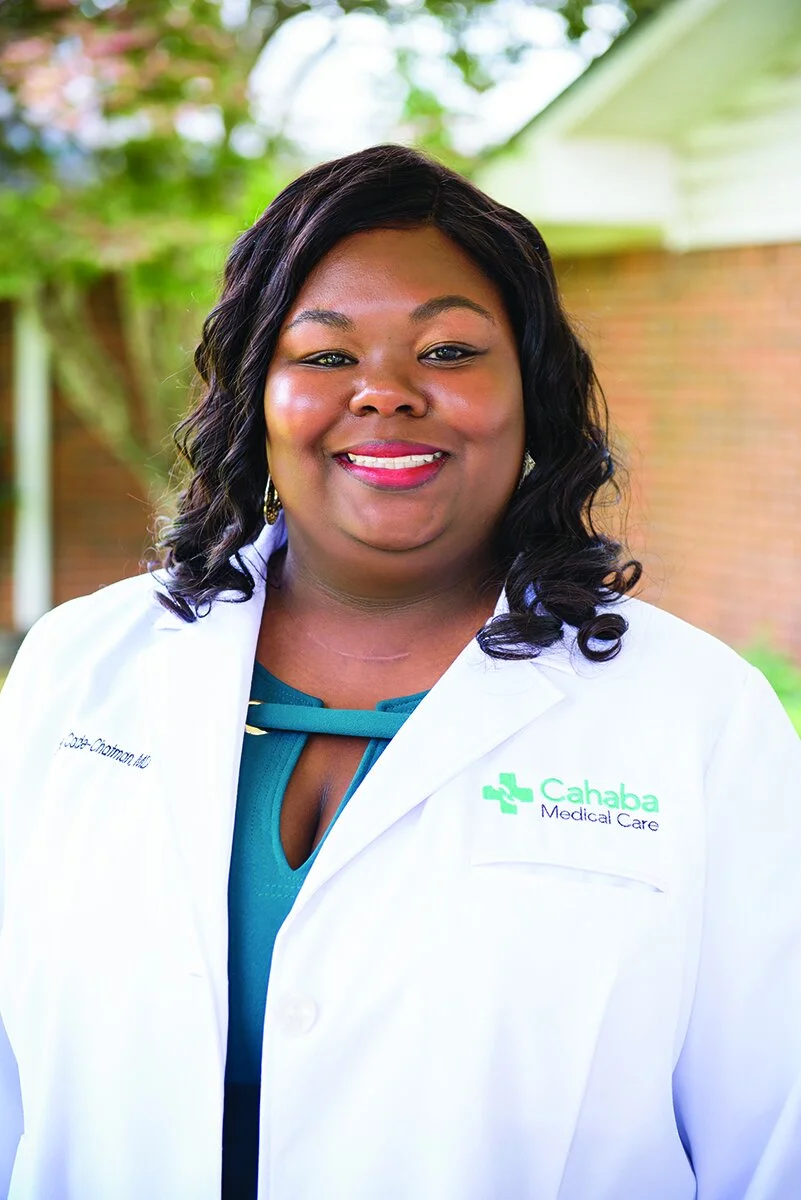Dr. Arnelya Cade Chatman Featured in UAB's Medical Magazine
**The following is from the article "Become Something You've Never Seen: Two alumni reflect on their paths to practicing rural medicine" by Lynne Hall, featured in UAB's Medical Magazine Winter 2023 edition.
A Journey Worth Taking
By age four, Heersink School of Medicine 2015 alumna Arnelya Cade Chatman, M.D., was proclaiming her goal to become a pediatrician. High aspirations for a young Black girl growing up in the small town of Thomaston, Alabama (population 326), perhaps, but her exposure to the medical field had come early, when at age 2 she began a five-year ordeal of gastrointestinal symptoms that had her in and out of the hospital with no diagnosis. Finally, a doctor diagnosed the cause as anxiety.
“It was brought on by the death of my grandfather,” Chatman says. “He was my main caretaker and the loss was shattering. It was frustrating even back then being sick for so long and not getting a diagnosis.”
The summer following seventh grade solidified her determination to become a physician. Her grandmother experienced a stroke that summer, and her care fell to Chatman. She quickly learned how to cook, ensured her grandmother took her medications, and did all she could to nurse her back to health. It was her first health care success.
“Oh, she’s still with us,” Chatman laughs easily. “She’s still going strong at 97.”
Growing up in a small town, Chatman became aware of disparities in rural health care early on. The nearest physician was 26 miles away in Demopolis, which was a problem for those without transportation or money for gas. Lack of health insurance, hospital closures, elevated drug costs, an older and sicker population, and high poverty levels were, and still are, challenges for rural health in Alabama.
Chatman learned more about these disparities her junior and senior years of high school when she participated in the University of Alabama Rural Health Scholars (RHS) program and the Minority Rural Health Pipeline Program (MRHPP), where she lived on campus and took college courses, attended tutorials and seminars, and shadowed health care professionals, and took field trips to rural medical facilities.
“I was fortunate to be able to do those programs,” Chatman says. “I earned college credit, we learned about various health care professions, we met doctors, nurses, and pharmacists, and took tours of rural hospitals. Plus, I took chemistry and was able to use a lab for the first time. My high school was so small it didn’t have a working lab.”
Continuing in the Rural Scholars Programs after obtaining her chemical engineering degree at the University of Alabama, she was then accepted into the Rural Medical Scholars Program, where for the first time, the high school valedictorian and undergraduate magna cum laude student found herself struggling.
In addition to the sudden wave of new school work, the daytime sleepiness that had plagued her for years became overwhelming. She sought help and, again, spent years searching for a diagnosis.
“I just couldn’t stay awake to study. A 30-minute power nap would turn into two hours and I was really struggling.”
She somehow powered her way through her studies, earning her medical degree from Heersink School of Medicine. It wasn’t until her intern year of residency that she was diagnosed with narcolepsy and began taking medication. That (second) struggle for a diagnosis informs her patient care philosophy, she says.
“I don’t want my patients to go through that,” she says. “It’s important that they know I take them seriously and that I’m there for them.”
On Match Day, Chatman matched with Cahaba Medical Care in a new community-based family medicine residency program, a partnership with the Heersink School of Medicine’s Department of Family and Community Medicine. It was a natural fit. Cahaba Medical Care has locations in several Alabama counties, and is dedicated to helping both underserved urban and rural patients get the care they need.
Now practicing at the center’s office in Woodstock, Alabama, Chatman is happy for the resources they provide, including dieticians, social workers, counselors, prescription and financial assistance, and programs that help ensure patients with limited resources can get to specialist appointments.
“Cahaba has opened my eyes to what could be in all rural areas. You shouldn’t have to have less than just because you’re rural,” she says.
In addition to the care she provides at Cahaba, Chatman, like Anderson, is active in the SOM/MAA URiM initiative. She was featured in a promotional video for the initiative and continues to work with the Outreach Committee’s SPARK program to “spark” interest in the health professions in junior-high and high school minority students and provide mentorship. Her story, no doubt, is an inspiration and she is certainly a good role model for students who can see themselves in the woman who was once a little Black girl from tiny Thomaston, Alabama.
“It’s been quite the journey. If I had to do it all again, I would,” she says. “I really can’t see myself doing anything else. I’m fulfilled in what I do and I feel I’m making a difference. I really care about my patients and they care about me. It really is wonderful.”

